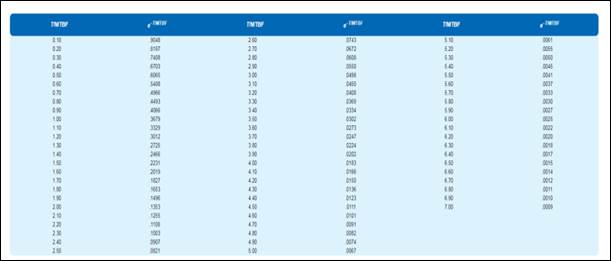
An electronic chess game has a useful life that is exponential with a mean of 30 month. Determine each of the following:
a. The probability that any given unit will operate for at least (1) 39 months. (2) 48 men the (3) 60 months.
b. The probability that any given unit will fail sooner than (1) 33 months. (2) 15 months. (3) 6 months.
c. The length of service tune after which the percentage of tilled units will approximately equal (1) 50 percent, (2) 85 percent, (3) 95 percent, (4) 99 percent.
a)
To determine: The probability the unit will operate at least for the following times.
Introduction:
Mean time between failures (MTBF):
The mean time between failures is a term which denotes the time that is elapsed between the first failure of a product and the second failure of a product. It is calculated during the normal system operation.
Answer to Problem 12P
1) 39 months = 0.2725
2) 48 months = 0.2019
3) 60 months = 0.1353
Explanation of Solution
Given information:
MTBF = 30 months
Formula to calculate the probability of no failure before a time period:
Calculation of probability:
1) 39 months:
Hence, the probability the unit will operate at least for the 39 months is 0.2725.
2) 48 months:
Hence, the probability the unit will operate at least for the 48 months is 0.2019.
3) 60 months:
Hence, the probability the unit will operate at least for the 60 months is 0.1353.
b)
To determine: The probability the unit will fail before the following times.
Introduction:
Mean time between failures (MTBF):
The mean time between failures is a term which denotes the time that is elapsed between the first failure of a product and the second failure of a product. It is calculated during the normal system operation.
Answer to Problem 12P
1) 33 months = 0.6671
2) 15 months = 0.3935
3) 6 months = 0.1813
Explanation of Solution
Given information:
MTBF = 30 months
Formula to calculate the probability of failure before a time period:
Calculation of probability:
1) 33 months:
Hence, the probability the unit will fail before 33 months is 0.6671.
2) 15 months:
Hence, the probability the unit will fail before 15 months is 0.3935.
3) 6 months:
Hence, the probability the unit will fail before 6 months is 0.1813.
c)
To determine: The length of service time for the percentage of failed units.
Introduction:
Mean time between failures (MTBF):
The mean time between failures is a term which denotes the time that is elapsed between the first failure of a product and the second failure of a product. It is calculated during the normal system operation.
Answer to Problem 12P
1) 50 percent = 21 months.
2) 85 percent = 57 months.
3) 95 percent = 90 months.
4) 99 percent = 138 months.
Explanation of Solution
Given information:
MTBF = 30 months
Formula to calculate the probability of no failure before a time period:
Calculation of probability:

The different probabilities are obtained from the above table.
1) 50 percent:
From the table for the value of 0.50 is equivalent to:
Therefore,
Hence, the length of service time for the percentage of failed units is 21 months.
2) 85 percent:
From the table for the value of 0.15 is equivalent to:
Therefore,
Hence, the length of service time for the percentage of failed units is 57 months.
3) 95 percent:
From the table for the value of 0.05 is equivalent to:
Therefore,
Hence, the length of service time for the percentage of failed units is 90 months.
4) 99 percent:
From the table for the value of 0.01 is equivalent to:
Therefore,
Hence, the length of service time for the percentage of failed units is 138 months.
Want to see more full solutions like this?
Chapter 4 Solutions
Operations Management
- An online news platform is hosting sports news on a local webserver. Assuming the webserver is valued at $10,000. This webserver crashed 7 times in one year and in every crash, it resulted in a 3% loss. Calculate the expected losses using single loss expectancy (SLE) and annualize Loss expectancy (ALE)arrow_forwardDetermine the optimum preventive maintenance frequency for each of the pieces of equipment if breakdown time is normally distributed: (Round "Probability Ratio" to 4 decimal places, and all other answers to 2 decimal places. Negative values should be indicated by a minus sign.) Use Table. Equipment. A201 B400 C850 Equipment A201 B400 CB50 Equipment Average Time (days) between Breakdowns A201 B400 C850 20 30 45 Preventive Maintenance Cost Click here for the Excel Data File: $330 $230 $580 Probability Ratio Standard Deviation 3 Breakdown Cont $2,230 $3,530 $4,825 Interval (days)arrow_forwardThe manager of the main laboratory facility at MetroHealth Center is interested in being able to predict the overhead costs each month for the lab. The manager that varies with the of lab performed but that some costs same each month of the lab tests performed. The lab manager collected the following data for the first seven months of the year. (Click the icon to view the data.) Read the requirements. Requirement 1. Prepare a scatter plot of the lab's volume (number of lab tests performed) and total laboratory overhead costs. Plot the points on the graph. (Enlarge the graph and use the point tool button displayed below to draw the graph.) Relationship of Total Laboratory Overhead Costs to Number of Lab Q Tests Performed Total Laboratory Overhead Co $36.000 $34.000- $32.000 $30,000 $28.000 $26.000 $24.000 $24,000 $22.000- $20,000- $18,000 $16.000 $14,000 $12,000 1,0001.7502 5003,2504,0004,750 Number of Lab Tests Performed Click to enlarge graph Data table Month January..... February....…arrow_forward
- The Worthington Gear Company installed a bank of 10 robots about three years ago. The robots greatly in-creased the firm’s labor productivity, but recently attention has focused on maintenance. The firm does no pre-ventive maintenance on the robots because of the variability in the breakdown distribution. Each machine hasan exponential breakdown (or interarrival) distribution with an average time between failures of 200 hours. Eachmachine hour lost to downtime costs $30, which means that the firm has to react quickly to machine failure.The firm employs one maintenance person, who needs 10 hours on average to fix a robot. Actual maintenancetimes are exponentially distributed. The wage rate is $10 per hour for the maintenance person, who can be putto work productively elsewhere when not fixing robots. Determine the daily cost of labor and robot downtime.arrow_forwardWhat happens to availability when MTTR (mean time between failures) gets close to zero? Is it possible to explain this circumstance accurately?arrow_forwardAn electronic chess game has a useful life that is exponential with a mean of 30 months. Determine each of the following:a. The probability that any given unit will operate for at least (1) 39 months, (2) 48 months,(3) 60 months.arrow_forward
- Performance Evaluation and Risk Aversion Jill Lewis is the office manager of PureBreds Inc.Her office has 30 employees whose collective job is to process applications by dog owners whowant to register their pets with the firm. There is never a shortage of applications waiting to be processed, but random events beyond Lewis’s control (e.g., employees out sick) cause fluctuations inthe number of applications that her office can process. Jill is aware that it is important that the applications be processed quickly and accurately. Alex Zale, the district manager to whom Jill reports,bases his evaluation of Jill on the number of applications that are processed.Required1. If Jill is risk averse, how should Alex compensate her? Why?a. Flat salary.b. Straight commission based on the number of applications processed.c. Flat salary with a bonus based on the number of applications processed.d. Flat salary with a bonus based on the firm’s earnings.2. What is a disadvantage of an evaluation method…arrow_forwardNon-inventory goods were purchased and delivered on June 15, 2010. Several security interests exist in these goods. Which of the following security interests has priority over the others? Group of answer choices purchase money security interest perfected June 24, 2010 Security interest perfected June 20, 2010 Security interest attached June 15, 2010 Security interest in future goods attached on June 10, 2010arrow_forwardThe availability of a system is affected when the mean time between failures (MTTR) is approaching zero. What do you think about this situation? Is it anything that can be correctly described?arrow_forward
- HW1 Q1 Consider the emergency department of a hospital that operates as follows: Upon arrival, patients first wait in line for registration. Then, after registration, patients wait to see a triage nurse who classifies them as either critical or non-critical. After the triage nurse, critical patients go to the emergency care area waiting to be seen by a doctor while non-critical patients go to the routine care area where they wait to see a doctor. It is determined that there are, on average, 20 patients registering or waiting to be registered, 5 patients being seen or waiting to be seen by the triage nurse, 15 critical patients being seen or waiting to be seen by a doctor in the emergency area, and 20 non-critical patients being seen or waiting to be seen by a doctor in the routine care area, Assuming that 20 patients arrive every hour and that 75% of the patients are non-critical, how many minutes does a patient spend on average in the emergency department of the hospital? Average time…arrow_forward7. A piece of equipment has a lifetime T (measured in years) that is a continuous ran- dom variable with cumulative distribution function F(t) = 1 – e/10 – (1/10) e¯/10 for all t> 0. a. What is the probability density function of T? b. What is the probability that a piece of equipment survives more than 20 years? c. What is the probability that a piece of equipment survives more than 10 years but fewer than 20 years? d. What is the probability that a piece of equipment survives more than 20 years given that it has survived for 10 years? 8. For the equipment mentioned in Problem 7, a. Derive the failure rate function r(1), and draw a graph of the function. b. Without using the failure rate function, determine the probability that a piece of equipment that has survived 20 years of operation fails in the 21st year. c. Does r(20) accurately estimate your answer to part (b)? Why or why not?arrow_forwardA copier machine has a mean time between failures of 400 operating hours. Repairs typicallyrequire an average of 10 hours from the time that the repair call is received until service is completed. Determine the availability of this copierarrow_forward
 Practical Management ScienceOperations ManagementISBN:9781337406659Author:WINSTON, Wayne L.Publisher:Cengage,
Practical Management ScienceOperations ManagementISBN:9781337406659Author:WINSTON, Wayne L.Publisher:Cengage,
